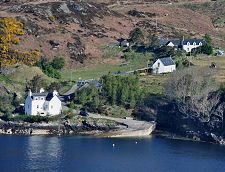 Stromeferry |
As the main A890 heads north from Lochalsh towards Wester Ross, there's a road sign pointing along a side road that descends to the north-west. It directs those who want to know that this is the way to Stromeferry, and for the avoidance of any possible doubt the road sign, like its predecessors that have stood here for the four decades we have been travelling this way, appends the words "(No Ferry)" to the placename.
So if there's no ferry in Stromeferry, why visit? To be honest, there's actually very little reason to take the short detour from the main road, unless you want a brief encounter with a quiet and gentle little place with a lot of character that's been repeatedly bypassed by history.
There is a railway station in Stromeferry, one of just five mandatory stops (the others are request stops) on the line from Inverness to Kyle of Lochalsh, but it's only used by 5-6 passengers per day to either arrive or depart. Beyond that there's a large slipway projecting out into Loch Carron that shows little sign of recent use, a few houses alongside the road that climbs up the hill from the loch, including a church converted to residential use, a burned-out hotel, and that's about it. Yet it's still a nice place to stop and spend a few minutes. (Continues below image...)
 The Old Ferry Slipway and Loch Carron |
Things were once very different. The Strome ferry began rossing here in 1809, to provide a missing link in the road then being built by Thomas Telford between Dingwall (then the county town of Ross-shire) and Kintail. This ran down through Lochcarron and the north shore of Loch Carron to North Strome, overlooked by Strome Castle. From there travellers crossed by ferry to Strome Ferry before completing their journey overland.
In 1870 Strome Ferry, as it was still called, became the terminus of the newly-opened Dingwall & Skye Railway, and a pier here was used by steamers to load passengers bound for Portree and to Stornoway. It is difficult to believe today, but on 3 June 1883, Stromeferry was the scene of a Sabbatarian riot in which over 200 fishermen occupied the railway station to stop the unloading of fish on a Sunday. It took the police and the army to quell the riot, ten men were subsequently imprisoned, and questions were asked in the in the House of Commons. The railway was extended to Kyle of Lochalsh in 1897, and Stromeferry's importance immediately diminished significantly.
History bypassed Stromeferry for a second time in 1970, when what has since been called the Stromeferry bypass, the A890, was built around the head of Loch Carron and along its south-eastern shore. The road rendered the ferry crossing redundant and the vessels were abandoned to rot on the north-west shore of the loch. At the time there were two ferries operating on the crossing, the Pride of Strome and the Forbes of Sandhaven.
For a few years in the mid 1970s Stromeferry became the railhead for the transfer of workers and materials to ships during the building of the enormous oil rig fabrication yard at Loch Kishorn, less than five miles away as the crow flies and a place that at its peak employed 3,000 people. They built amongst many other structures, the Ninian Central Platform. At 600,000 tonnes this still holds the record as the largest movable object ever created by man.
The A890 Stromeferry bypass has not been without its problems. On a number of occasions rockfalls onto the lochside section north of Stromeferry have blocked the road, sometimes for significant periods of time. Closure of the bypass entails a 140 mile detour by road via Inverness. During the most recent major closure, in January 2012, a passenger ferry had to be introduced to link Lochcarron with Plockton, not least to ensure schoolchildren could continue with their education. Meanwhile, vehicle traffic was transported between the slipways at Stromeferry and North Strome using the MV Glenachulish, the turntable ferry normally used to operate the Summer-only ferry service between Glenelg and Skye. Plans have been under discussion for many years to bypass the Stromeferry bypass, by bridge over, or tunnel under, the narrowest part of Loch Carron at Stromeferry, or (perhaps more likely) by building a new road along a glen some two miles inland. None of the options are cheap, which is why discussion has been under way for so long.
As you spend your quiet few minutes in Stromeferry, think on all of this and remember that this place has not always been quite so quiet as it is today. As for the ruin of the Stromeferry Hotel, it's not clear when this fell out of use, but it was apparently broken into and stripped of internal fittings in June 1992, and badly damaged by fire in July 1993. It has since stood pretty much as you see it today, and plans in 2008 to covert it into a guest house and restaurant have not (yet, at least) come to fruition.
 Stromeferry, No Ferry |

|
|
|
Visitor InformationView Location on MapWhat3Words Location: ///thrones.organist.travels |
 A House With a View |
 The Old Ferry Slipway |
 Distant View of North Strome |
 North Strome Slipway |
 Fishing Boat in Loch Carron |
 Brae Cottage |
 Start of the Stromewood Footpaths |






